Marketing Automation Platforms: What You Need to Know
You've heard about marketing automation and marketing automation platforms. You probably know a lot of marketers that are infatuated with the term. But at the end of the day, what the heck is it? In this post, we're going to cover the fundamentals of marketing automation , what we've learned in the field working with our own partners and marketing to local businesses. We'll explain what exactly marketing automation platforms are, how they can help you drive revenue and debunk a few widespread misconceptions.
What is Marketing Automation?
There are a ton of different definitions of marketing automation. In a nutshell, though, marketing automation really just refers to any type of technology or software that exists to automate the marketing process. Instead of having eight different people come up with tags and slicing and segmenting and hooking up to CRMs and ERPs and all that, the goal of marketing automation platforms is to automate those repetitive tasks and allow you to focus on delivering customized and personalized messages to the end recipient.
My thoughts? Let's make it easier. What marketing automation should be is the processes to deliver more relevant and more timely value to an audience at scale, with better personalization. It’s the idea of mass personalization and moving people toward a state where we strike when the iron's hot, sending them relevant and targeted content, but also nurturing them into a state where they are ready to buy. It creates not just customers, but delighted customers that you continue to communicate with and send important, relevant information to. Marketing automation platforms make for an overall better experience in the relationship without sinking a ton of time and money into the system. Yes, it's about acquiring new customers, but it’s also about continuing to deliver personalized value throughout the lifecycle of the relationship.
Marketing Automation Platform Challenges
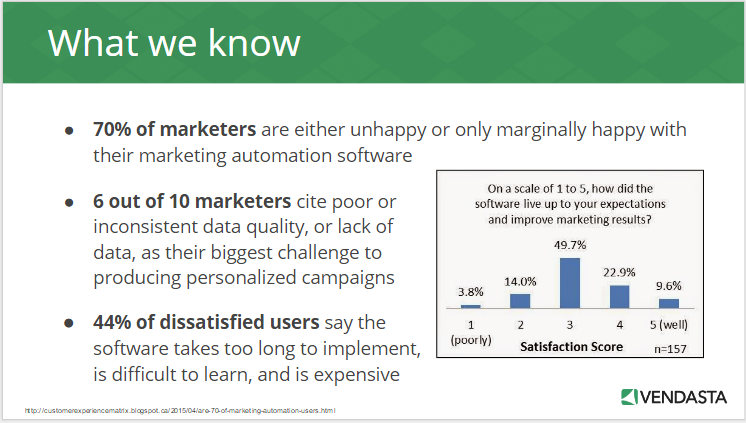
Unfortunately, some of the current marketing automation systems are a little tough to implement. It’s tough to make sure you're getting continual value. Not only do you need to set up and implement the system, but you also need to ensure that you utilize all the features and functionalities available. Here are the main issues.
Bad data
Six out of ten marketers cite inconsistent data quality or lack of data, yet data is so important with marketing automation platforms because it’s the foundation to make sure that you are getting the personalized message to the right people.
Complexity of implementation
The next problem is the length of time that it takes to get up and running. It takes 59% of businesses up to six months to fully adopt and implement marketing automation platforms on average. If you think about cutting a check to someone for six months before you actually start to see value in a system and start to see leads being generated, that might be a dealbreaker. You need to shorten that time frame, and start getting hot leads right away.
Relevance
Businesses don’t want information that’s not relevant to them. Sending out a Snapshot Report is all about giving them content about their business, and no one else. Not stats on the industry, but their business compared to their industry. So pinpointing businesses, both when they have a good score they need to maintain or a negative score they need to improve, is essential. Marketing automation platforms allow you to address the customer when they are ready to buy. Just because someone has a terrible car doesn't necessarily mean they are in the market for a new car. It might be that guy or gal that has a 2015 car that wants the latest and greatest all the time. It's about making sure we understand their needs state, as well as their interest level.
Time sensitivity
Time sensitivity is a big thing here. When you are engaging a customer, you are seven times more likely to convert a lead when you have followed up within the first hour. When you talk to people when they are interested and perhaps when they are even reading about it or looking for it—right place, right time—the conversion rate goes up.
The right solution at the right price
The last piece is making sure that you’re offering solutions to your customers at the right price point and service model. So, if a customer doesn't want to buy the huge ad spend or the massive bundle, we don't necessarily have to get in a car and find out that they just want the base package. We can use powerful tools like marketing automation platforms and better segment these customers based on their lifetime value or their interest level. What marketing automation platforms do is helps you identify those customers and segment them at the right price point and right service model.
Ideal Marketing Automation Platforms
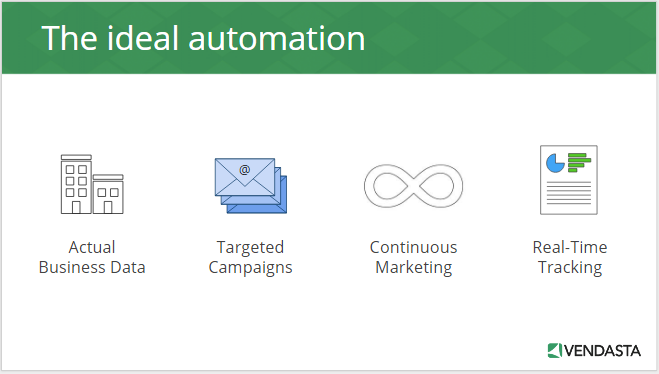
The ideal solution boils down into four components. That is, let's get some actual, real business data. Let's get some information about this prospect and send them something that's targeted, perhaps give them a sneak peek to get them interested. Make sure that the content actually piques their interest and grabs their attention. The third part is making sure that we're delivering things that offer value to keep them engaged, and perhaps bring them to a point in the buying cycle where they're ready to engage further. Then, this is all rooted in real-time tracking and getting that information back to the sales organization so that they know exactly who to talk to and when.
So, turns out personalization works. When you personalize an email, the click-through rates go up significantly. Emails with personalized subject lines are 7% more likely to be opened! Customers want information that is about them, don't just spam things about the general population. Emails with personalized tags inside of them or content or subject lines are significantly more likely to be opened.
The other challenge we have is just lack of data. Awesome, I have a list of customers, but I really know nothing about them. Or it's just a stagnant list in a spreadsheet, or I have exported it up out of my CRM. What can you tell me about these customers?
So what’s needed for ideal marketing automation? We need smarter systems and strategies. I was at a conference recently and I loved this quote, “Drowning in data but thirsty for information.” We have oodles upon oodles of information and data right now, and the agencies that will succeed are the ones that can have smarter systems to make this data valuable and turn it into relevant information. Using tools that help you segment customers based on what you are looking for, or delivering information based on different needs of that customer, at the end of the day, that's what's really exciting about where marketing automation is headed.
Marketing Automation’s Key Stakeholders
Start by thinking of your key stakeholders. What does each of them need to do their jobs better? These are the stakeholders Vendasta looks at, and they might be different in your organization. If you come to the Vendasta headquarters in beautiful sunny Saskatoon, you're going to see these folks up on the wall. They are all life size, and we have these different user personas and buyer personas everywhere to make sure we keep our development and content practices centered around the people who actually use our software.

The Marketing Manager
First we have a marketing manager. She has different needs perhaps than a sales manager. Maybe these are the same person in some of your organizations and maybe even all four of them are the same person. Let's dive into what Miranda, the marketing manager, needs.
- Personalized, relevant content that doesn’t cost an arm and a leg to produce
- Easy implementation that works out of the box
- Analytics to understand ROI
Marketing managers, first and foremost, are highly interested in cost of lead and ROI on their marketing efforts. So starting at that end, analytics to understand ROI, getting that feedback and making sure the campaigns Miranda’s team are running are translating into leads and constantly iterating and optimizing. It’s the thought that when I am spending money, show me that it's working. Show me that I am doing something. And when it's working, tell my why it's working, so that I can keep doing more of it. She wants personalized, relevant content that doesn't cost an arm and a leg. Perhaps she is the one managing the marketing budget and it's on her to find the best system that works. Probably the biggest headache that Mirandas of the world run into is the time to value or TTFV, time to first value, with a system. So helping to solve Miranda's needs, and maybe you are one of the Mirandas, that's an issue for you as well.
The Sales Manager
Bob is a sales manager and, just like our sales manager, what does Bob want?
- Expectation management for the manager’s team (and data to hold them accountable)
- Best sales practices and pipeline management with robust analytics
- Marketing after the sale to grow share-of-wallet
Bob wants to make sure that he has the information that he needs to hold his team accountable. So when marketing says, "I give him the sales team's leads and they aren’t taking advantage of them," Bob needs that information so he can go and he can help manage and coach those teams. Or perhaps, go back to the marketing team and say, "No, it's not quite qualified” or “these aren't the best potential customers for our business." He's really interested in how marketing and sales communicate and work back and forth. Along with that, Bob needs to make sure that they are taking advantage not only of the first sale, but also of the upsell and growing that share-of-wallet as well.
The Sales Rep
Next we have Vern the sales rep, and what does a sales rep want?
- Pleasantly persistent campaigns that follow best practices for sales
- Contact leads 10x for max engagement
- Alerts upon engagement to allow for quick follow-up
- Qualified leads
Vern the sales rep wants to make sure that he is getting qualified leads. Vern wants to make sure that when he goes after those leads, that it's not a phone slam or a door in the face, but that these leads are a little bit warm. Marketing automation is a great way to do this is once you've nurtured them a little bit, so the sales call is not a completely cold call. It's more of a value add or a consultative approach, where you can couple that data that you've learned about the business with some of that interest you're seeing from the customer to provide a non-creepy, targeted approach that's relevant to that business. Along with that, he wants to know if someone is engaged. And Vern wants to know now, not four weeks from now when the leads have gone cold. Helping Vern get information about the leads in a timely manner is essential.
The Business Owner
Lastly, we have the Sally the business owner. What do the Sallys of the world want?
- Relevant, prescriptive content
- Education: solutions to the problems they’re facing (and the ones they don’t even know they have)
- An agency of record; one login and one contact for all of their marketing solutions
- To know how they compare to competitors
Relevant and prescriptive content is key here. Just like we as customers want, don't address me as Bobby Joe if my name is not Bobby Joe. Tell me that you know about me and about my business, and about me as a consumer. Business owners want relevant, prescriptive and valuable content. So, rather than constantly buy this, buy that, take an educational approach where you're offering value through your emails, like blog articles and best practices, or the 10 tricks on how to do X. Marketing is really about being helpful and that social contract in offering something in return for something else.
What we also know about business owners is that they want one login and one contact. What we refer to it is a throat to choke. They want to know that one person is taking care of them. They don't want to work with 18 different vendors and service providers—business owners need someone to help them. That's what you're providing. Being that agency of record and sending them content that is valuable, but also being that one source that they could go back to with any questions.
The Core Pieces of Marketing Automation
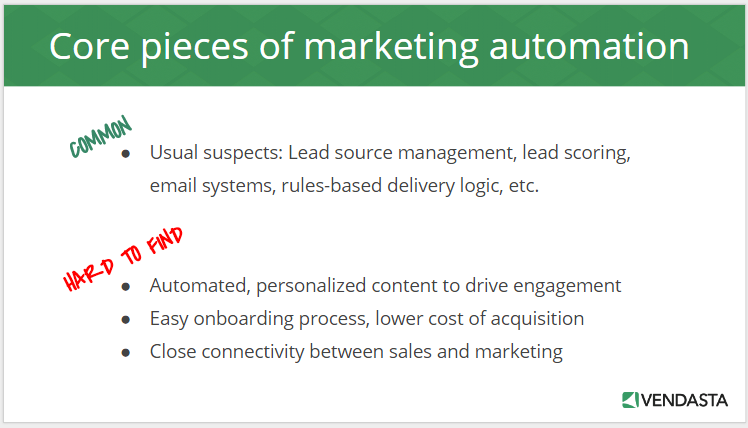
What we've seen in the marketplace of marketing automation platforms is that a lot of them have the basics like lead source management, and rules-based logic delivery functionality. However, when we talk about time to set up, it becomes that six-months-to-deliver type of situation. Jeff Tomlin, our CMO, has a saying that's resonated in the company and that is, "The only terrible thing about some marketing automation is there is really nothing automated about it."
It takes a lot of time and effort to set up this logic, and when you get it wrong, it's a whole mess to redo. What the new era of marketing automation platforms are doing is taking the data that we know, or that the system knows about it, and automatically setting up that personalized content and campaigns. Everything from acquisition to adoption campaigns to upsell or retention or conversion campaigns, there is a lot of new technology now that is going in that direction. I encourage you to look at systems that do just that. That was a hint of Vendasta, really.
Content is King
At the end of the day, it's not the frequency or the number of emails that you send, it’s about delivering value. You need to make sure that with the emails you send, the content is timely, valuable and personalized. That way people truly want to stay subscribed because they are getting value.
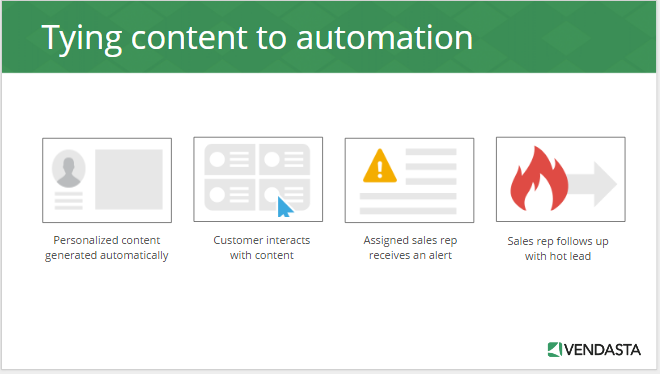
It's expensive, obviously, to do some of these things. Costs of $50 per hour per person setting up, designing the HTML and the emails, the designer, the copyright, it gets up there, right? But when you have a system that has some of those campaigns already drafted, you can bypass some of these costs.
So what about content that's already created? Well, for those of you who have run a marketing automation campaign, or that are using the Snapshot Report to pique interest and continue to drip out customers, you know that there is really no better content than the Snapshot Report. That’s because you can send it, drive interest and continue to talk and drive that customer back to check out their report. Again, it's all about their business. So if you want to talk about that social contract, offer value before you ask anything in return.
Vendasta’s Marketing Automation Platform
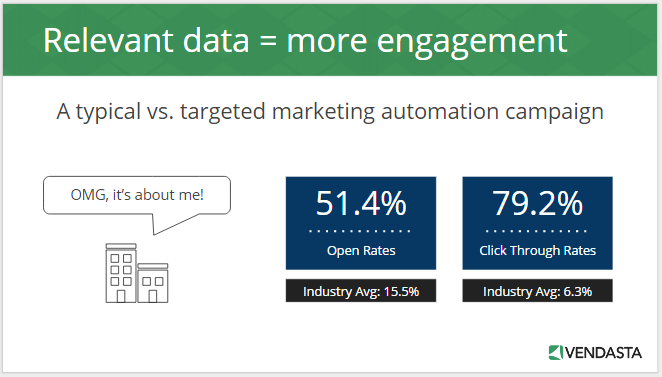
These are open rates and our click-through rates from a campaign that we've done in marketing automation. This is not pie-in-the-sky outrageous, this is from a real campaign and we’ve done many of these with partners. It boils down to a relevant customized subject line, a relevant report about their business and messaging that offers value. The proof really is in the pudding.
Along with Vendasta's marketing automation platform, we also let you know who is opening these emails and engaging with them. Additionally, through the CRM, you can see what type of activity your prospects are engaging in through the feed. You can see when they've opened the email, when they've clicked through to the report, maybe they've made it into their Business App login and they're clicking around and viewing different products.
Well, I know that if they have perhaps taken a look at the Reputation Management products and gone back again, as a sales rep, first thing I'm going to do is take a look at their Snapshot Report. Maybe they are getting a D or a C or an F in reviews and they're checking our Reputation Management. Probably a good chance that not only are they in the market for a car, but they need a new car. Could be a very, very qualified lead.
If you haven't run a marketing automation campaign, I encourage you to do so. It doesn’t have to be in bulk! It can be firing out a couple of snapshot reports, subscribing them to a drip campaign and giving it a try. See if you get any response. Let us know what happens in the comments below!

